Friday, December 31, 2021
Wednesday, December 15, 2021
Washington, DC, sues Proud Boys, Oath Keepers over Jan. 6
Washington, DC, sues Proud Boys, Oath Keepers over Jan. 6
By ASHRAF KHALILyesterday

Members of the Oath Keepers on the East Front of the U.S. Capitol on Jan. 6, 2021, in Washington. The District of Columbia has filed a civil lawsuit seeking harsh financial penalties against far-right groups Proud Boys and Oath Keepers over their role in the Jan. 6 attack on the Capitol by supporters of former President Donald Trump. (AP Photo/Manuel Balce Ceneta)
WASHINGTON (AP) — The District of Columbia has filed a civil lawsuit seeking harsh financial penalties against far-right groups Proud Boys and Oath Keepers over their role in the Jan. 6 insurrection at the Capitol by supporters of former President Donald Trump.
The suit, filed Tuesday in federal court, also names dozens of the groups’ senior members, many of whom already face criminal charges for taking part in the violent attack on the Capitol building while Congress was meeting to certify the 2020 election results.
Karl Racine, Washington’s attorney general, said the lawsuit seeks compensation for damages to the District of Columbia and intends to inflict maximum financial damage on the groups responsible.
“Out intent is to hold these violent mobsters and violent hate groups accountable and to get every penny of damage we can,” Racine said. “If it so happens that we bankrupt them, then that’s a good day.”
ADVERTISEMENT
There was no immediate response to emails sent to the groups seeking comment.
The lawsuit cites as its basis a post-Civil War 1871 law known as the Ku Klux Klan Act. A similar tactic was used to secure a $26 million verdict last month against white supremacist groups and individuals responsible for organizing the violent 2017 Unite the Right rally in Charlottesville, Virginia, in which one person was killed after a man plowed his car into a group of counter-protesters.
The lawsuit came as the Justice Department on Tuesday separately charged three more suspected members of the Proud Boys from Pennsylvania for their alleged roles in January’s riot.
The men, Isaiah Giddings and Freedom Vy of Philadelphia and Brian Healion of Upper Darby, are all accused of working with another suspected Proud Boys member, Zachary Rehl — who was arrested in March — to breach the Capitol. Prosecutors say the group traveled together from Pennsylvania and the trio was photographed posing both outside the Capitol and inside the building.
Racine announced the suit Tuesday alongside Eleanor Holmes Norton, D.C.’s non-voting delegate in the House of Representatives. Norton said the suit is designed to secure extra funding to support D.C. police officers injured while defending the Capitol building and to serve as a warning to extremist groups.
“They’re going to have to spend money to defend themselves,” Norton said. “Even if we don’t get a penny in restitution, this lawsuit’s deterrent effect will say, ‘Be prepared to spend money to defend yourself because we are coming after you.’ ”
Racine said evidence presented in the multiple federal criminal cases underway already proves “explicit evidence of conspiracy” to commit violent acts in the nation’s capital. He said the lawsuit presents an opportunity to publicly explore and expose the financial support structure of the far-right extremist network.
“I sure hope they try to defend the case,” he said. “We can’t wait to propound searing questions about the finances of these individuals and these groups.”
The Proud Boys emerged from far-right fringes during the Trump administration to join mainstream GOP circles. The Oath Keepers is a militia group founded in 2009 that recruits current and former military, police and first responders.
Sunday, December 12, 2021
Russia edges closer to war as new arms arrive on Ukraine’s border
Russia edges closer to war as new arms arrive on Ukraine’s border
A recent sighting of Putin’s notorious Buk missiles on their way to the frontline does not bode well for talks

A flatbed rail wagon speeding through south-west Russia last week carried an ill omen for negotiations to avert a larger war with Ukraine.
On board was a Buk-M1, the kind of medium-range surface-to-air missile system that became notorious in 2014 after a missile fired from territory controlled by Russian proxies in eastern Ukraine shot down a Malaysian airliner, killing all 298 people aboard.
If Russia goes to war in Ukraine, it still needs to take a number of steps: establishing fuel supply lines, opening field hospitals and deploying air-defence systems such as the Buk that would protect its heavy weaponry and troops near the front.
Advertisement
Even as Joe Biden and Vladimir Putin were sitting down to talks meant to end the crisis, Russia was inching closer to being ready to launch a full-scale ground invasion of its neighbour.
“These data allow us to conclude that despite the negotiations between Biden and Putin, the concentration of Russian troops in the areas bordering the territory controlled by the Ukrainian authorities continues,” wrote the Conflict Intelligence Team (CIT) – an online research group that has used social media, railway schedules and other data to reveal details of Russia’s military buildup on the border.
Putin may still decide not to launch an invasion, as he leaves troops near the front as leverage for negotiations. But Russian and western analysts are predicting that this military buildup – the second one this year – portends a series of future crises over Ukraine as Putin seeks to reverse its trajectory towards the west.
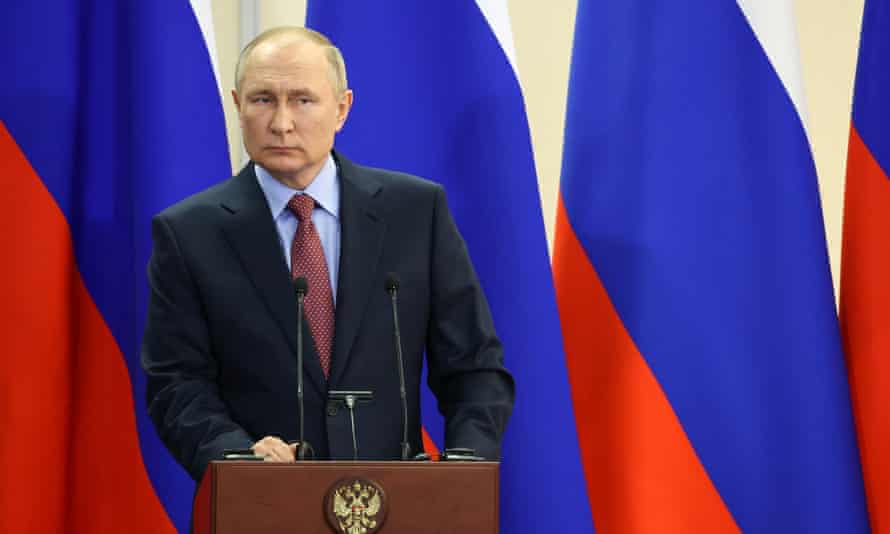
Advertisement
“Even if Putin gets something from the west, serious talks or discussions about guarantees – will that be enough for Putin?” said Tatiana Stanovaya, founder of the political analysis firm R.Politik. “We are witnessing the dawn of a new geopolitical adventurism from Russia.”
Despite the Putin-Biden talks, the crisis is growing deeper.
On Thursday, Russia’s FSB said it had intercepted a Ukrainian ship in the Sea of Azov near Crimea for failing to obey orders. A day later, Russia closed nearly 70% of the Sea of Azov, a shared body of water also used by Ukraine, for firing drills. Then there is the escalating rhetoric.
Deputy foreign minister Sergei Ryabkov has said Russia and the US may be hurtling towards a repeat of the 1962 Cuban missile crisis. And Putin said that the situation in eastern Ukraine “looked like genocide” in a recent meeting, raising fears he could seek a pretext to send his troops into the country.
With its military threat on the table, Russia’s foreign ministry released its list of demands for how to end the crisis on Friday. Chief among them was for Nato to “officially disavow the decision of the 2008 Bucharest Nato summit that ‘Ukraine and Georgia will become Nato members’”.
Putin has spent the last two decades trying to fight Nato expansion, but the possible accession of Ukraine into the military alliance has always touched deeper emotions, and in part motivated him to order the annexation of Crimea and provoke a war in eastern Ukraine that has killed more than 14,000 people.
“I told them: please don’t touch Ukraine or there’s going to be a problem,” said Fyodor Lukyanov, an influential Russian foreign policy analyst, of his discussions with western colleagues about Nato’s enlargement in the 2000s. “There is a real red line. Right or wrong … this kind of engagement with Ukraine on security and military affairs – that is seen here as absolutely unacceptable.”
Lukyanov said Putin saw it as his “duty as president” not to leave the “Ukrainian problem” – meaning its trajectory towards the west – for the next Russian leader.
The US has sought to persuade Russia that Ukraine would not join the alliance any time soon, but on Friday Moscow demanded a more formal declaration. That was a non-starter, Nato head Jens Stoltenberg said within hours of the demand being made public. “Nato’s relationship with Ukraine is going to be decided by the 30 Nato allies and Ukraine – no one else,” he said during a press conference with Germany’s new chancellor, Olaf Scholz.
In Ukraine, support for joining Nato has jumped considerably in recent years as the country has sought protection from an increasingly aggressive Russia. And for the nations on Nato’s eastern flank, allowing Russia to dictate the alliance’s policy on Ukraine is seen as the first step down a slippery slope towards recognising a Russian sphere of influence.
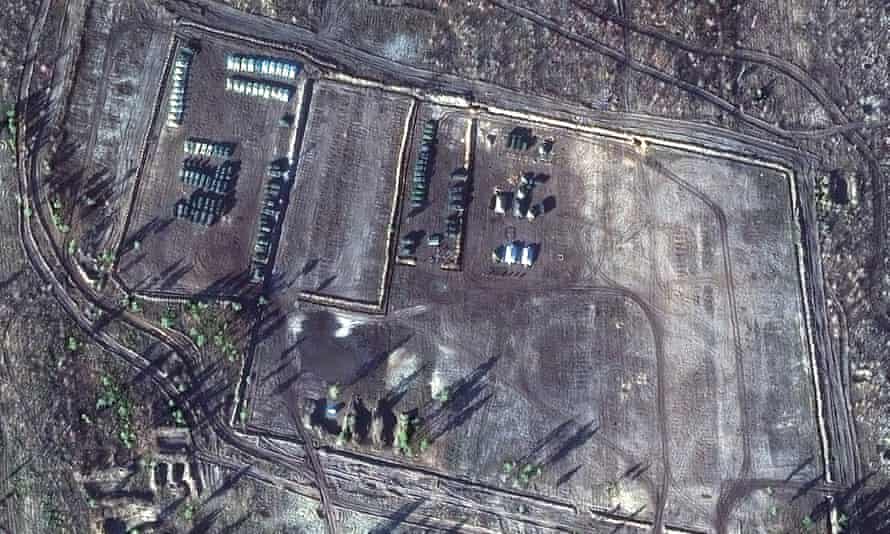
Advertisement
“History shows that pledges of neutrality by Ukraine or any other country in the region do nothing to abate Putin’s appetite; rather, they feed it,” wrote Ukraine’s foreign minister, Dmytro Kuleba, in an article published by Foreign Affairs on Friday. “The best way to respond to such ultimatums is to ignore them altogether.”
There are doubts whether Russia really wants to strike any deal at all. Analysts noted that despite Moscow building up its forces for months, Russian diplomats had not prepared any formal documents or even formulated the country’s demands until last week. And the idea of mustering nearly 100,000 troops within striking distance of the Ukrainian border (the US has said that Russia could increase that number to 175,000 by the end of January) just to hold talks with Biden has struck western observers as overkill.
That brings us back to the Buk, which, as CIT noted, had its numbers crudely painted over in an effort to prevent identification. Russia employed similar tactics during its clandestine invasion of Ukraine in 2014.
The clock is ticking. Putin could pull back, but it would be embarrassing to do so without a solid win in hand. And Russia’s demands look impossible to fulfil for the west: “Putin thinks that if Biden wants, he can move mountains, he can convince allies and convince Kyiv [to make concessions],” said Stanovaya. “This problem could lead Putin to demand the impossible and push the stakes so high that everything ends in war.”
… as you're joining us from Japan, we have a small favour to ask. Tens of millions have placed their trust in the Guardian’s high-impact journalism since we started publishing 200 years ago, turning to us in moments of crisis, uncertainty, solidarity and hope. More than 1.5 million readers, from 180 countries, have recently taken the step to support us financially – keeping us open to all, and fiercely independent.
With no shareholders or billionaire owner, we can set our own agenda and provide trustworthy journalism that’s free from commercial and political influence, offering a counterweight to the spread of misinformation. When it’s never mattered more, we can investigate and challenge without fear or favour.
Unlike many others, Guardian journalism is available for everyone to read, regardless of what they can afford to pay. We do this because we believe in information equality. Greater numbers of people can keep track of global events, understand their impact on people and communities, and become inspired to take meaningful action.
We aim to offer readers a comprehensive, international perspective on critical events shaping our world – from the Black Lives Matter movement, to the new American administration, Brexit, and the world's slow emergence from a global pandemic. We are committed to upholding our reputation for urgent, powerful reporting on the climate emergency, and made the decision to reject advertising from fossil fuel companies, divest from the oil and gas industries, and set a course to achieve net zero emissions by 2030.
Sunday, October 24, 2021
China is removing domes from mosques as part of a push to make them more 'Chinese
China is removing domes from mosques as part of a push to make them more 'Chinese'
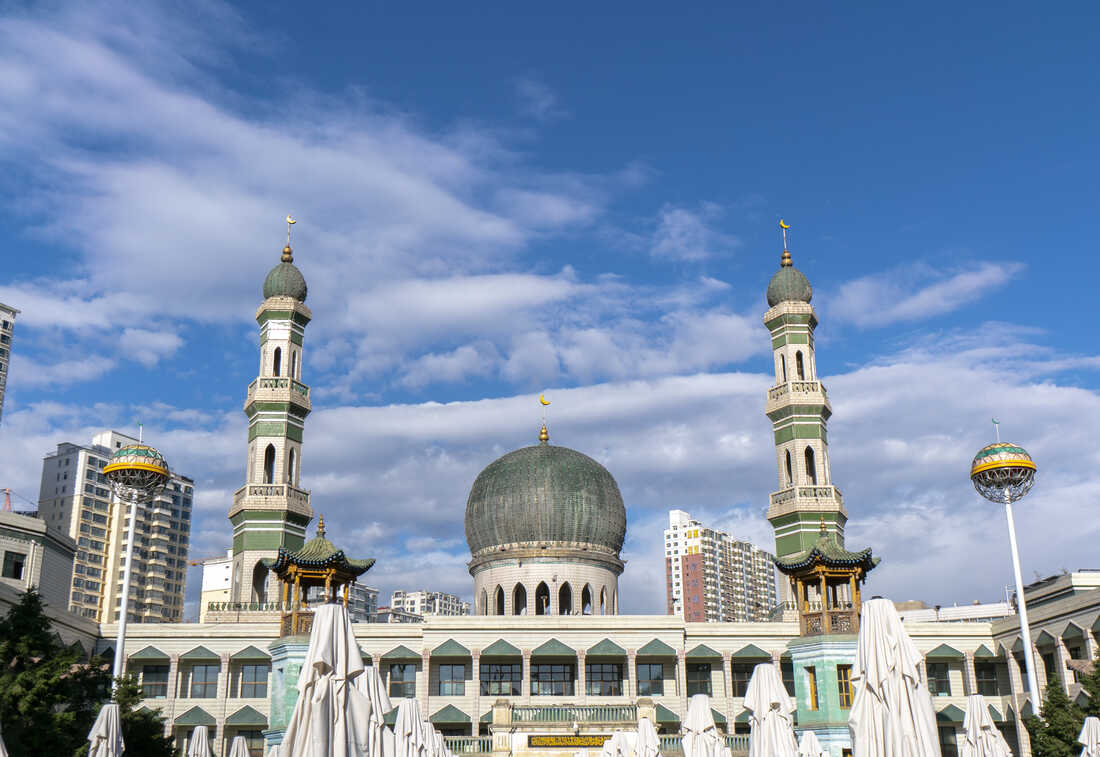
The Dongguan Great Mosque in Xining, China, photographed in 2018. Its main green dome and minaret domes have since been removed.
XINING, China — The Dongguan Mosque has adopted some very different looks in its nearly 700 years in China's northwestern city of Xining. Built in the style of a Chinese imperial palace, with tiled roofs and no domes, and adorned with Buddhist symbols, the mosque was nearly destroyed by neglect during political tumult in the early 20th century. In the 1990s, authorities replaced the original ceramic tiles on the roof and minarets with green domes.
This year, provincial authorities lopped off those domes.
"The government says they want us to 'sinify' our mosques, so they look more like Beijing's Tiananmen Square," says Ali, a Muslim farmer selling pomegranates outside the mosque. He requested that NPR use only his first name because residents have been ordered not to speak about the dome removals. "I think the mosque looks good either way, but what say do we have anyways?"
China is removing the domes and minarets from thousands of mosques across the country. Authorities say the domes are evidence of foreign religious influence and are taking down overtly Islamic architecture as part of a push to sinicize historically Muslim ethnic groups — to make them more traditionally Chinese.
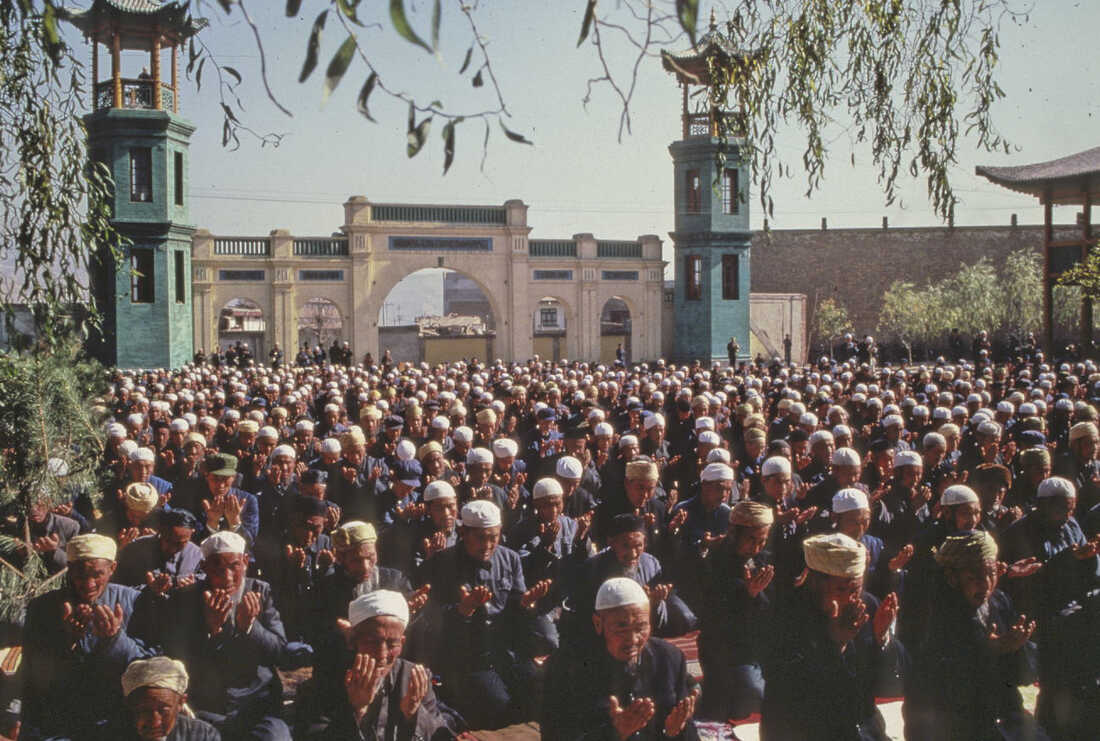
Xining's Dongguan Mosque has been a source of community for Chinese Muslims for seven centuries. Here, Hui Muslim men pray in the mosque in 1983.
The campaign comes amid rising Islamophobia in China and growing religious restrictions, touching off a discussion across the country among scholars, ethnic policy regulators and historically Muslim Chinese communities about what exactly should be considered "Chinese" to begin with.
Article continues after sponsor message
China's approach to ethnic minorities has shifted to "sinicization" under Xi Jinping's rule
China's ethnic policy is directly modeled on the Soviet approach, classifying citizens into 55 distinct ethnic minority groups, each of which, in theory, is granted limited cultural autonomy within its territory. But experts say the Communist Party under Xi Jinping's rule has shifted to a new approach, one that favors integration and assimilation — a process dubbed "sinicization" in official speeches and documents.
"A very liberal or positive view of all this [sinicization] is just basically to compare it to, say, what's it like to become an American citizen? You accommodate and people adjust," says Dru Gladney, an expert on Islam in China at Pomona College.
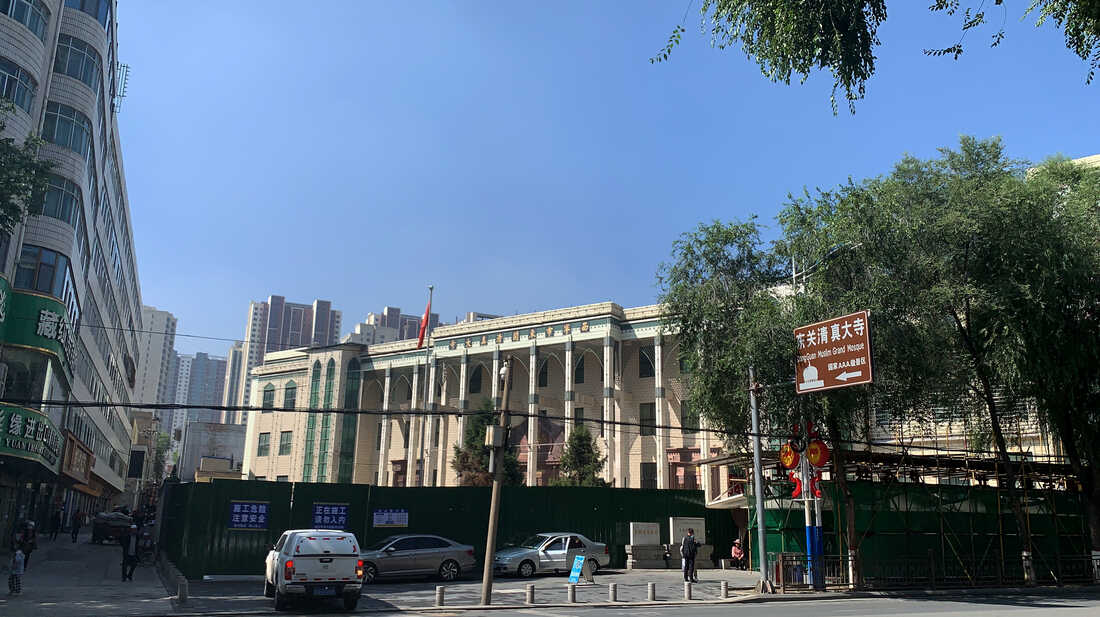
The Dongguan mosque in September. China is removing the domes and minarets from thousands of mosques across the country. Authorities say the domes are evidence of foreign religious influence. They are taking down overtly Islamic architecture as part of a push to sinicize historically Muslim ethnic groups — to make them more traditionally Chinese.
After more than 1,300 years of living and intermarrying in China, Hui Muslims — who number about 10.5 million, less than 1% of China's population — have adjusted by becoming culturally and linguistically Chinese. They even made their version of Islam accessible to Confucians and Daoists — trying to show it as inherently Chinese and not a foreign influence — by adopting spiritual concepts and terms found in ancient Chinese philosophy to explain Islamic precepts.
Various Hui sects have also incorporated Chinese religious practices into their worship, such as burning incense at religious ceremonies. Hui communities in central Henan province are even known for their female-only and female-led mosques, believed to be a uniquely long tradition in China.
The problem from Chinese authorities' perspective, says Gladney, is that the Hui are not Chinese in the way sinicization proponents want: "When people make this one-way argument of sinicization, I think they're confusing that with Han-isization" — in other words, making Chinese Muslims more like China's Han ethnic majority.
Beijing has a much narrower understanding of what being "Chinese" means – adhering to Communist Party values, speaking only Mandarin Chinese and rejecting all foreign influence, say scholars.
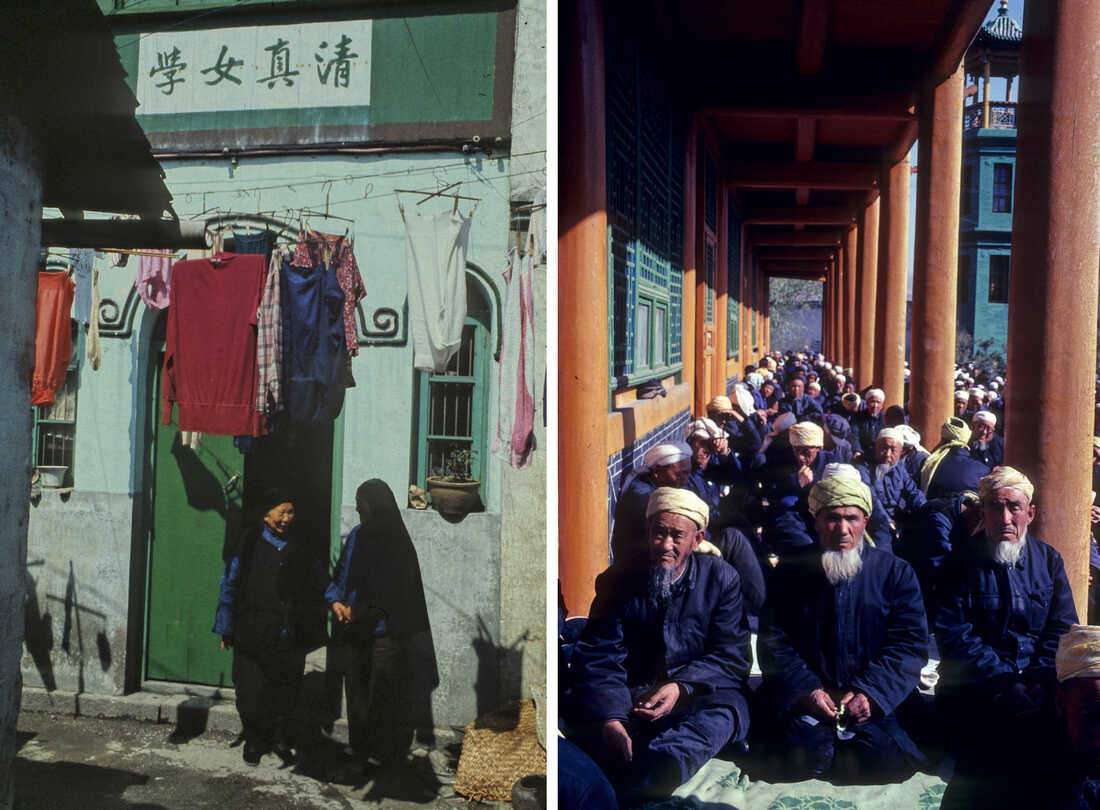
Left: The entrance to a women's-only mosque in the town of Jiaxing near Shanghai, in the 1980s. Female-only mosques were once common in Chinese Muslim communities. Right: Hui Muslim men in Xining's Dongguan Mosque in 1983. Hui Muslims number about 10.5 million, less than 1% of China's population.
"The Communists nowadays try to culturally rule China," says Ma Haiyun, an associate history professor at Frostburg University.
Authorities began taking down mosque domes a few years ago in an effort to remove "Saudi and Arabic influence"
The streets of Xining city in China's Qinghai province are redolent with reminders of China's historically multiethnic and co-religious composition. Many people wear the white cap or scarf favored by Hui Muslims, and visitors are equally likely to hear Mandarin Chinese as the Tibetan spoken by about a fifth of Qinhai's population. Roughly one-sixth of the province's population belongs to ethnic groups China classifies as Muslim.
At the heart of the city's hustle and bustle is the Dongguan Mosque, Xining's largest. In restaurants that crowd the alleyways around the mosque, vendors hand-pull halal beef soup noodles. Carts piled with dates and almonds cluster under brick archways.
But missing are the big green domes that once crowned its minarets and prayer hall. Under the slogan of "removing Saudi and Arabic influence," authorities have torn down the domes from most mosques across China's northwest as part of a national removal campaign that began in earnest in 2018.
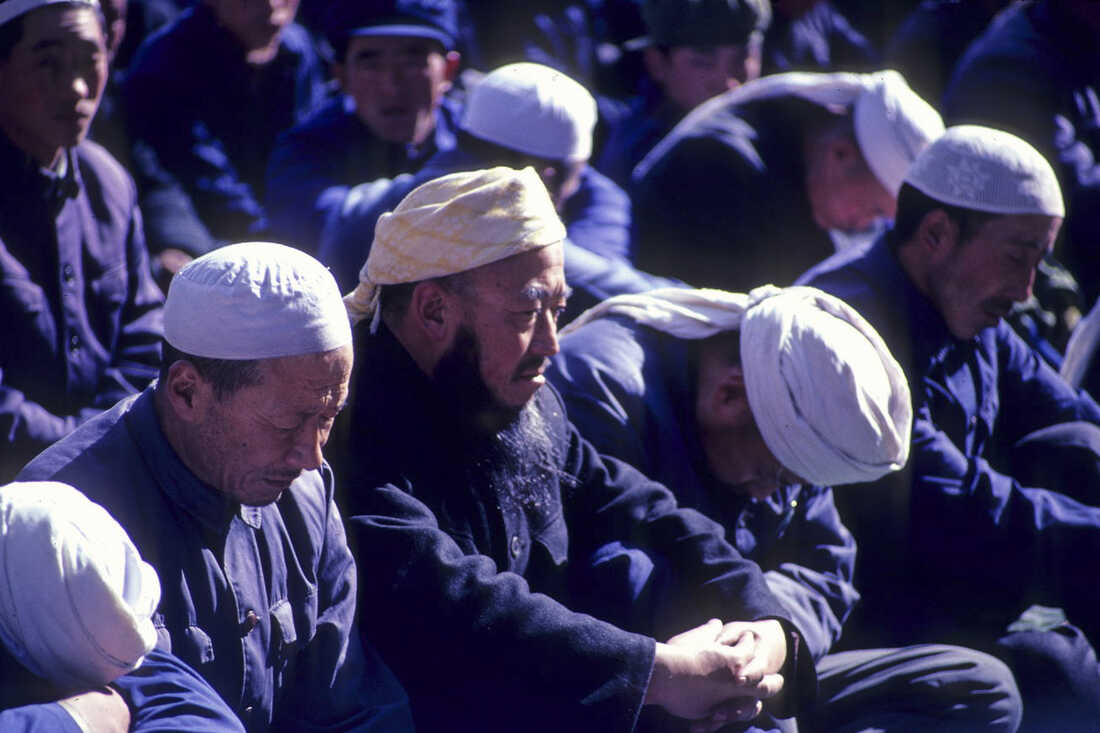
Hui Muslim men in Xining's Dongguan Mosque in 1983. In other parts of China, sinicization has allowed the state to justify the confiscation of mosque assets, the imprisonment of imams and the closure of religious institutions over the last two years.
Xi first called for sinicization in 2016. In August, he gave a speech saying religious and ethnic groups should "hold high the banner of Chinese unity" — meaning they should put Chinese culture ahead of ethnic differences.
The dome removal campaign has met with limited public resistance. Xining residents say the Dongguan Mosque's imam and director were briefly detained and forced to sign in favor of it. Less than a mile away, Xining's marble Nanguan Mosque is also being prepped for dome removal. A shell of bamboo scaffolding encases its white dome.
"The local residents are spreading rumors," said a man who declined to identify himself and tried to prevent NPR from taking pictures outside the mosque. Despite the removal of the Dongguan Mosque's domes, he insists they are still in place. "Dongguan's and Nanguan's domes are preserved. Some might have been taken down for renovation."
In other parts of China, sinicization has allowed the state to justify the confiscation of mosque assets, the imprisonment of imams and the closure of religious institutions over the last two years.
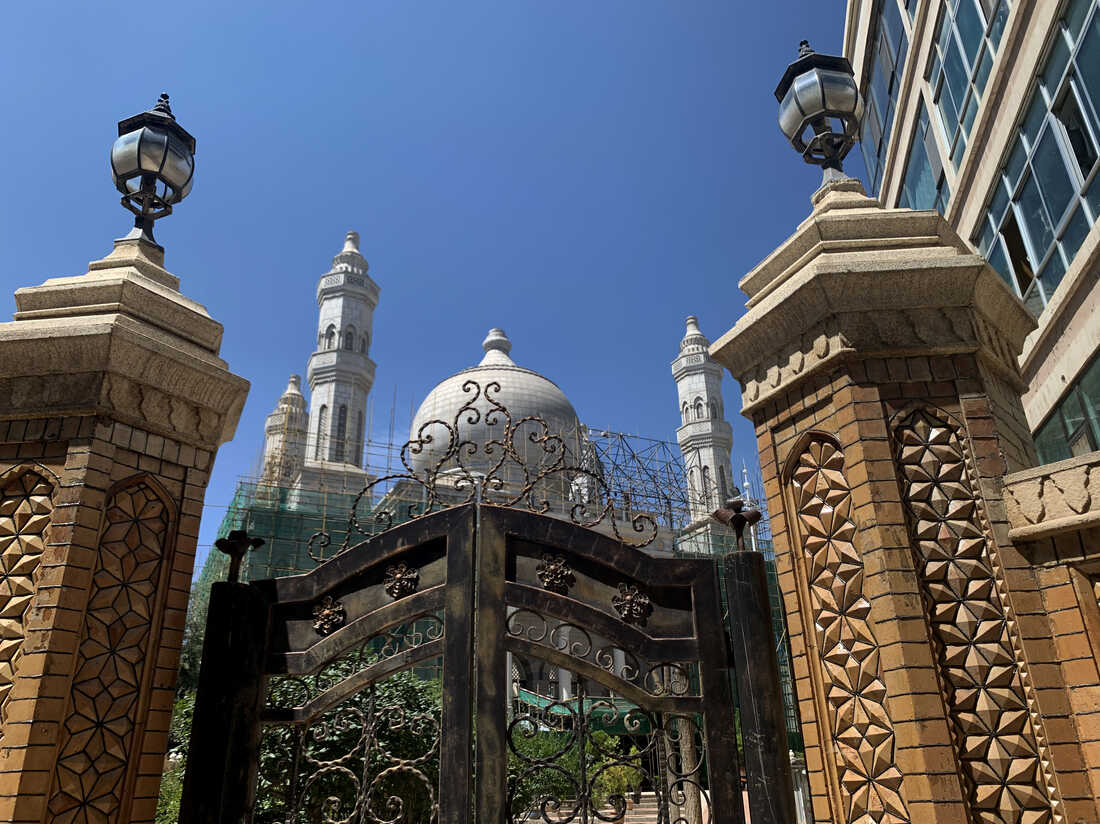
Dome removal preparations are under way at the Nanguan Mosque in Xining city. But China's efforts at cultural control are most heavy-handed in the western region of Xinjiang, where authorities detained hundreds of thousands of ethnic Uyghurs in camps. Beijing says the camps are schools that teach the Chinese language and Chinese communist theory.
It has also buttressed simultaneous restrictions on the use of non-Chinese languages, such as Tibetan or Uyghur. In the province of Inner Mongolia, peaceful mass protests broke out last September but were quickly stifled after schools reduced the time devoted to teaching the Mongolian language in favor of Mandarin Chinese.
China's efforts at cultural control are most heavy-handed in the western region of Xinjiang, where authorities detained hundreds of thousands of ethnic Uyghurs in camps Beijing says are schools that teach the Chinese language and Chinese communist theory. The state has also damaged or outright demolished thousands of Xinjiang mosques and religious sites.
Hui Muslims continue to adapt
The dome removal at Xining's Dongguan Mosque has split China's already fractious Muslim community, which is prone to sectarian divisions, according to Frostburg's Ma, who was born in Xining and was raised around the mosque.
"If you remodel this mosque and create some chaos [among the Muslim community]. You already have different sects starting to rise in Xining ... I think the government is trying to divide and rule," says Ma.
The state itself is also divided over what Chinese mosques should look like.
In the 1990s, as China opened up politically, local leaders encouraged Persian Gulf states such as Kuwait and Saudi Arabia to invest money into massive infrastructure projects aimed at internationalizing the once-closed Communist country. More Chinese Muslim students were able to study abroad in Middle Eastern countries, especially in Egypt, the United Arab Emirates and Saudi Arabia, and they brought back new ideas about Islamic architecture.
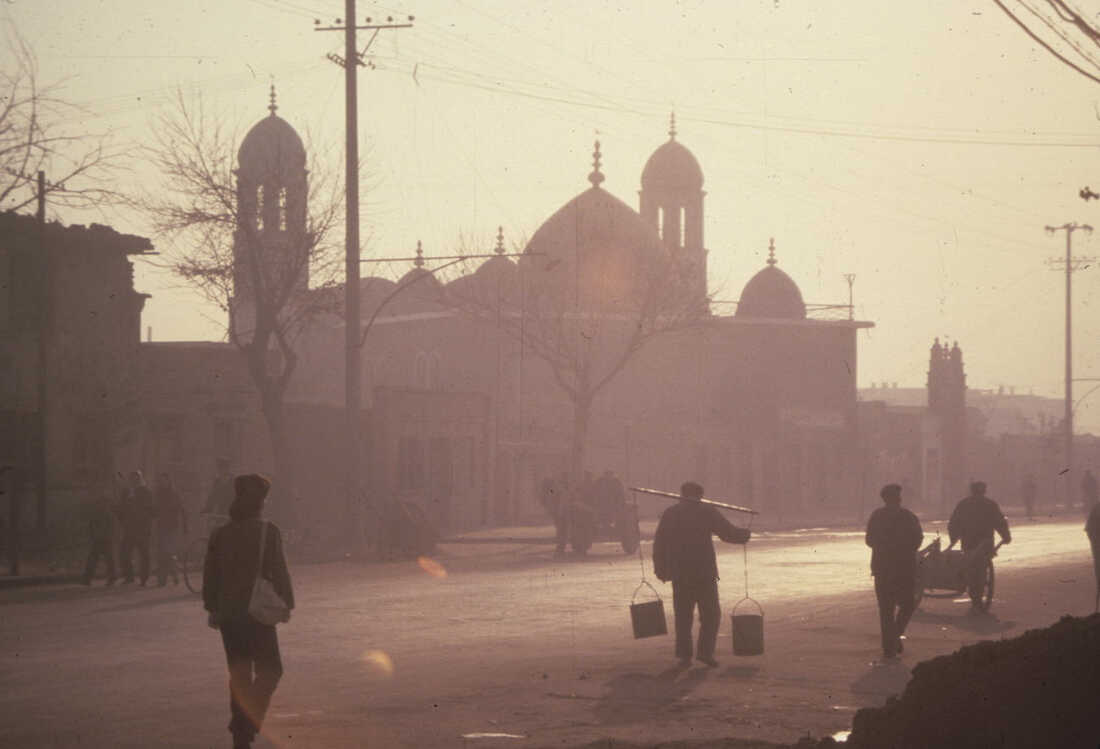
A scene from Xining in the early 1980s. The current sinicization campaign comes amid rising Islamophobia in China and growing religious restrictions, touching off a discussion across the country among scholars, ethnic policy regulators and historically Muslim Chinese communities about what exactly should be considered "Chinese" to begin with.
As part of these modernization efforts, authorities also tore down centuries-old Chinese-style mosque roofs— including the ones which graced the Dongguan Mosque — and built Arabic-style domes.
In previous conversations Gladney had with local governments intent on adding domes to old Chinese mosques, "I was jumping up and down, saying, 'don't do it, don't do it,'" he says. "You can build your dome and your new mosque next door, but preserve what you have here."
The Hui Muslims, for the most part, have accommodated the ever-changing cultural pressures around them.
Yusuf, the Muslim owner of a store near the Dongguan Mosque selling Muslim head coverings and halal beauty products, says the Hui must continue to adapt, as they have for centuries, to survive. He requested that NPR only use one name because residents may face state retribution for speaking about religious affairs with foreign journalists.
"Everything changes from one era to another. During Chairman Mao's time, they tore down all our mosques. Then they built them up. Now they are tearing them down again! Just follow whatever political slogan the country is yelling at the time."
For the third time in under a century, the Dongguan Mosque is going through another makeover — and that's fine with Yusuf.
"To the average person, Chinese style, Arabic style... we don't care! Our faith does not exist in our buildings. It lies in our heart," he says, thumping his chest emphatically.
Subscribe to:
Comments (Atom)
The Truth is ..All Lives Matter .

The Truth is ..All Lives Matter , it's SAD to Find out some People think black Lives Doesn't Matter or they Matter LESS😡
Using a Vehicle as a Weapon

Using a Vehicle as a Weapon
Animals Use their Mouth as a Weapon. What do Humans Use as a Weapon ? Atomic , Nuclear , Vehicles ,

Humans use Guns , Knives , RPGS...etc
dark tracker

dark web
V 8765487654
F 97654487543
m

b
Racism

Injustice
WE ARE ALL RUSSIAN SPIES

INCONSPICUOS AGENTS
S 87654487543
B 876544876
Hiroshima and Nagasaki.( August 6-9 )

Humans are a Million times More Dangerous than Animals
History of Palestine

Bitter Truth
Cyberspace Solarium Commission

Defense
Canadian Dark History

Residential Schools
Lost Homes

Palestine
No Justice ,No Peace
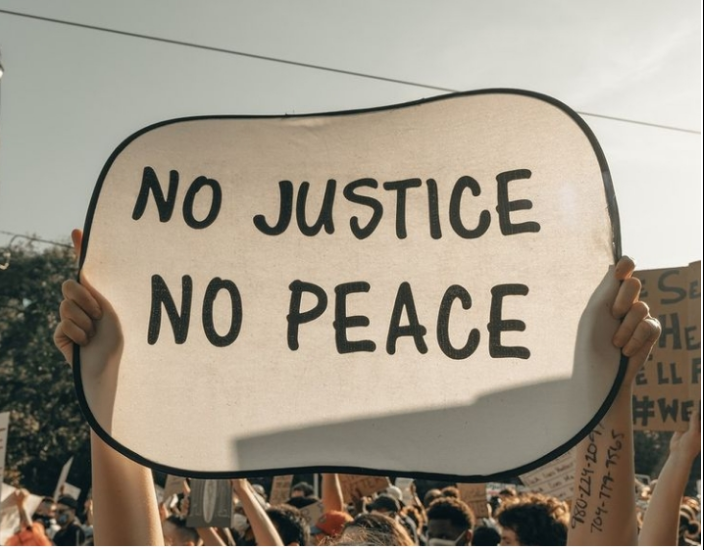
Straight forward
Middle East

Statistics
Al Quds day

Palestine
Executions...Top ten

Y 2020
Ff

Pp
N

D
M

V
My Home . Earth. Seen from the Red Planet.

Earth seen from mars
NASA

Logo
Mars'Touchdown
Police Brutality

How Many Weren't FILMED ?
Fb

Warning
The NRA
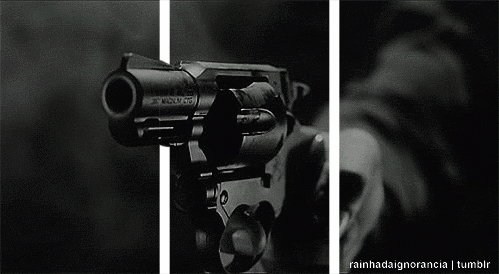
Guns and Gangs
Doomsday

Clock
K 446578
- 222 TIPS - Crime Stoppers
- CID Kenya
- 25 Most Failed States
- Failed State
- VICE...
- Ontario Crime Stoppers
- Breitbart
- Bill C-7. Dying
- Police Brutality
- UN for Climate change
- Justia
- Amnesty international
- Toronto Police News. Release
- The Criminal Code of Canada
- D.O.D. USA News release
- D.O.D. Usa
- Halifax Security Forum
- Munich Security Conference
- Bill C 22
- 5 th. Homicide of 2021
- Global Uranium Time lapse
- Global Nuclear Timelapse
- Crime Stoppers
- Terrorist by County
- next block homicide
- 9-11 Attacks
- Fox on Terror
- Qasem Soleimani Assassination 😡
100 seconds. Doomsday Clock

To Midnight
Homicide

Book
Crime

Vocabulary
Mig 66654
AN INCIDENT or AN ACCIDENT

POLICE
Black

Tears
R

E
D 87544678
Doomsday Clock
Doomsday Clock closest to midnight in 73 years amid nuclear war fears, climate change:
C 87655
2 - Fire

Building Burning - Grenfell
Sherif

Coroner
X 87675657
Rip off
Scams
Crimes
Frauds
ONLINE
Predators and Preys
FOOD CHAIN
Introduction: PredationEdit
Ultimately, the source of energy for all life originates from the sun. Plants utilize the sun's energy, animals eat plants and utilize the plants' energy, and some animals eat other animals and utilize their energy. The food chain is a cycle of predation, and although it is necessary for life to exist, it has to have limits. Prey develop defenses against their predators, and predators strive to overcome such obstacles. The balance between survival of prey and predator is part of the reason that our ecosystem is so diverse.
Nuclear Reactors in the world. About ~ 500

HIROSHIMA: 75 years since atomic bomb obliterated city

atomic bomb
Doomsday

Clock
Ontario Nuclear Alert

Warnings
Knife

Attack
What's NOT Available on the INTERNET ?
What's NOT Available on the INTERNET ?
What can't we access online ?




